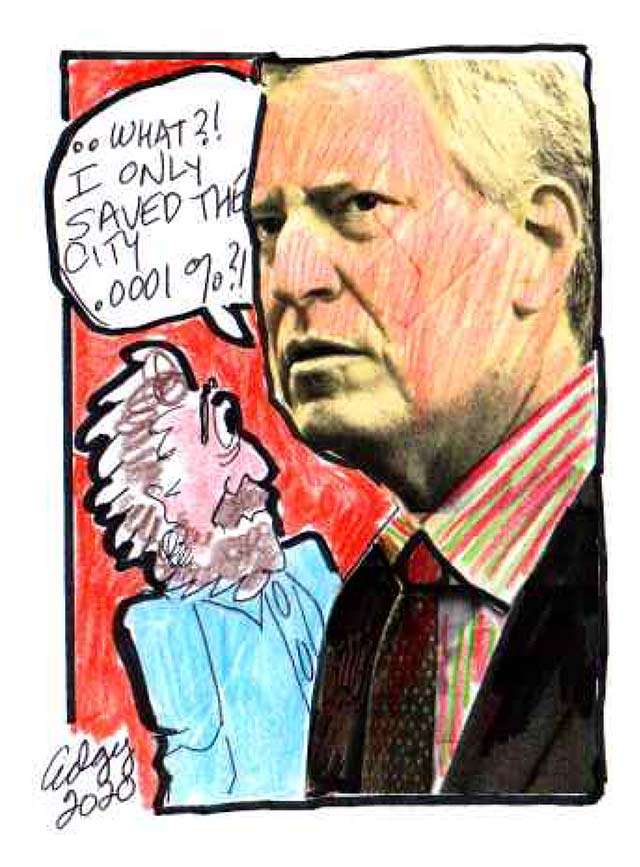Meet the (Mis)Calculating NYC Mayor Bill de Blasio!
Math nerds unite! What follows may need correcting
By Ed Goldman
Last month, New York’s mayor, Bill de Blasio, did a one-week layoff of 495 city employees to save a reported $860,000—of an annual budget estimated to be more than $86 billion. We’re talking savings of .00001 per cent. I tried working that out on my smartphone’s calculator and it said a bad word.
Overdue Bill
For his part, de Blasio said he also would take no pay—something many New Yorkers thought should have happened since the time he was photographed eating pizza with a fork. (It apparently raised the question of whether he was an actual New Yorker.)
In the Museum of Ill-Considered Ideas, de Blasio’s budget strategy may merit a special kiosk. In fact, not since the introduction of New Coke in 1985, nor the debut of the original Ford Pinto in 1971, has an idea seemed so likely to figuratively go flat or to literally backfire, respectively.
Why? you may ask. The reasons are many.
1. Okay, the numbers may not sound all that bad at first. If you divide $860,000 by 495 employees, you come up with about $1,737 per week, per employee. Multiply that by four and you arrive at an average monthly salary of about $6,950 per employee. Multiply that by 12 and you learn that the average salary is just shy of $84,000 per year.
That sounds pretty thrifty for Manhattan until you read that de Blasio mainly targeted “administrative assistants” to work without pay for a week. Also his wife(!) and her staff(!), who are on the city’s payroll. I think I smell something—and it isn’t pizza).
What you don’t find being “furloughed” are the high-end NYC bureaucrats, some of whose salaries are at least $240,000. Of the city’s 325,000 employees, there are about 294,000 full-timers. Had de Blasio thought to send home a group of these characters, even for only a week, the savings could have been impressive—like in the many millions of dollars.
2. The trouble with getting rid of certain government employees, of course, is you may find out they’re not missed. I’ve seen this happen first-hand. In about 1975, some middle-managers at Lakewood City Hall decided to strike for higher wages. (I worked there for a couple of years so I could dash to my parents’ home a few miles from the government’s HQ every day at lunchtime and help my mom care for my dad, who was very ill.)
The result was not what the middle-managers, all men, had envisioned. Since their work consisted primarily of approving the work performed by others “below” them (including me), nothing was affected by the middle-managers quasi-walkout. The work still got done—and, without the doers having to wait for memos about it, it got done much more quickly. Even the local newspaper barely acknowledged the job action, if that’s what it was. I imagine it was hard for the rebels to raise their fists in solidarity salutes while wearing Permanent-Press leisure suits, which didn’t provide much freedom of motion (I hasten to remind you this was about 1975, one of the years the gods of fashion and taste decided to go on sabbatical.)
In the end, the city manager, with the blessing of the city council, made a deal: The “rebels” could keep their jobs if they returned to work immediately and never mentioned their attempted coup again. Ever.
You may recall that six years ago, in another brilliant cost-cutting move, de Blasio wanted to lay off the horses (and thereby end the carriage rides) in Central Park. I wrote about it for my daily column in the Sacramento Business Journal—the gist of which was that I was not only against cutting the iconic horse-drawn gambols through the park but was also applying for a job to be one of the beautiful beasts providing them:
“According to what I’ve been reading about the growing controversy, the horses work a maximum six-hour day and never when the weather is very cold or very hot. They even receive a five-week vacation in the country each year—and that, if you’ll pardon the expression, ain’t exactly hay.”
To make my point, I name-dropped like crazy after finding out that film actor Liam Neeson was furious about the planned cutback and thought de Blasio might therefore want to reconsider:
In the end, the measure was amended and the horses more-or-less kept their jobs. But I still kind of wish it had come to a fight between Neeson’s “Star Wars” light-saber and de Blasio’s pizza fork.
Ed Goldman's column appears almost every Monday, Wednesday and Friday. A former daily columnist for the Sacramento Business Journal, as well as monthly columnist for Sacramento Magazine and Comstock’s Business Magazine, he’s the author of five books, two plays and one musical (so far).














